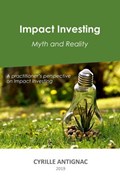Impact Investing is now well-publicized, along with other categories of sustainable investment. Recognized as an asset class on its own right since 2010, impact investing has registered the fastest growth in all categories of investments. This remarkable performance is attracting increasing attention as well as raising questions on the realities and practices of impact investors.
Written by a practitioner, this book aims at offering some answers and shedding some light over what constitutes impact investing. It covers Impact Investing in practice with case studies to illustrate innovation fostered by impact entrepreneurs as well as techniques of impact investors. Then, it focuses on measuring impacts in a « triple bottom-line » perspective. Finally, the book closes on a review of trends and outlook for impact investing.
The author distinguishes between classic social business known for low-return and « patient » capital with innovation-driven ventures strategically intent on addressing market needs in the multi-billion strong population with low income below two dollars per day. The latter category presents opportunities for large capital appreciation and already signals unicorn-like performance.
The book explains how impact investing tends to focus increasingly on tech-based innovation for social and environmental improvement. It shows how such innovation can be market disruptive and open very large markets at the base of the social pyramid by addressing pent-up demand. Impact ventures that are successful in opening these markets through affordable and inclusive solutions, tend to create new market dynamics on which to deliver high investment multiples for investors.
Impact investors worldwide are seeing the emergence of innovative business models intent on solving issues around poverty, social integration as well as climate change and environment depletion. This is particularly true in Asia where impact investing is called to a bright future with only a small fraction of global impact capital to date despite sustained growth and stiff exposure to social pressure arising from urbanization, industrialization and climate change.
Against this backdrop, Southeast Asia, the « third engine » of Asia-Pacific, presents an attractive case for impact investing. Already a global spot for venture capital with over twelve unicorns since 2012, ASEAN is home to a growing nexus of impact ventures, all building on a « social-tech » approach to develop solutions addressing the needs of people and planet.

